Spectrum Allocation Based on an Improved Gravitational Search Algorithm †,
Abstract
:1. Introduction
2. System Model
2.1. Graph Coloring Model Based on CRN
2.2. Problem Formulation
3. Technologies
3.1. Critical Technologies
3.1.1. Encoding and Decoding
3.1.2. Population Initialization
3.1.3. Position Modification
3.2. Algorithms
3.2.1. Basic Thoughts
3.2.2. GSA in IGSA
3.2.3. PSA in IGSA
- Building pattern. The PSA pattern is obtained by constructing a group of vectors. The group consists of a list of new points around the base point, which is used for the fine search of a base point. The vector of i-th base point is built in this way:where I is an identity matrix, D is the encoded length of spectrum allocation, is a vector group built for the base point .
- Forming mesh. The PSA establishes a series of points centered around the base point, which is called mesh. The following formula is used to generate mesh:where {} represents the new alternative point set of the base point , is the mesh size.
- Polling. In the search process of PSA, the optimum point among and original base point is selected to be the new base point of the next iteration, the new point is denoted as . Polling has two kinds of results: polling success and failure. Polling success means that an alternative point in mesh is better than the base point, otherwise polling failure.
- Adjusting mesh size. If polling success, the new alternative point replaces the base point and then use Equation (26) to enlarge mesh size (or step size) of searching, otherwise, the original base point is retained and then use Equation (27) to shrink the mesh size.where and denote the enlarge factor and shrink factor, respectively.
4. Spectrum Allocation Based on IGSA
- Step 1:
- Initialization. Generate the system environment; initialize the parameters and constants of IGSA; define the objective function; set the maximum iteration time of GSA and PSA , , respectively.
- Step 2:
- Population initialization. Build chaotic population for IGSA using the Chebyshev chaotic map (in Section 3.2.1).
- Step 3:
- Exploration. Employ GSA to explore the search space and obtain the close-to-optimal solution.
- Step 4:
- Exploitation. Initialize PSA with the optimal solution obtained from GSA, use PSA to exploit the local area.
| Algorithm 1: An Improved Gravitational Search Algorithm. |
 |
5. Simulation Experiment
5.1. Evaluation Criteria
- System utility: the total system utility of a spectrum allocation scheme, which is used to validate the total revenue of the system, that is
- System fairness: the standard deviation estimation of SU, which is used to validate the fairness of SUs access into spectrum, that is
- System overall performance: the total capacity of the system, which is used to validate the overall system performance, that is
5.2. Experimental Environment and Parameter
5.3. Simulations and Analyzation
6. Conclusions
Acknowledgments
Author Contributions
Conflicts of Interest
References
- Niyato, D.; Hossain, E. Cognitive radio for next-generation wireless networks: an approach to opportunistic channel selection in ieee 802.11-based wireless mesh. IEEE Wirel. Commun. 2009, 16, 46–54. [Google Scholar] [CrossRef]
- Alfa, A.S.; Maharaj, B.T.; Lall, S.; Pal, S. Mixed-integer programming based techniques for resource allocation in underlay cognitive radio networks: A survey. J. Commun. Netw. 2016, 18, 744–761. [Google Scholar]
- Tamilarasan, S.; Kumar, P. Dynamic resource allocation using priority queue scheduling in multi-hop cognitive radio networks. In Proceedings of the 2016 IEEE International Conference on Computational Intelligence and Computing Research (ICCIC), Chennai, India, 15–17 December 2016; pp. 1–5. [Google Scholar]
- Rungsawang, P.; Khawne, A. The implementation of spectrum sensing and spectrum allocation on cognitive radio. In Proceedings of the International Conference on Advanced Communication Technology, Bongpyeong, Korea, 19–22 February 2017; pp. 817–821. [Google Scholar]
- Li, J.; Liu, Y.; Li, Q.; Wang, L. Spectrum Allocation in Cognitive Radio—Quantum Immune Clonal Based Approach. In Proceedings of the 2014 International Conference on Cyber-Enabled Distributed Computing and Knowledge Discovery, Shanghai, China, 13–15 October 2014; pp. 441–447. [Google Scholar]
- Tanab, M.E.; Hamouda, W. Resource Allocation for Underlay Cognitive Radio Networks: A Survey. IEEE Commun. Surv. Tutor. 2017, 19, 1249–1276. [Google Scholar] [CrossRef]
- Tragos, E.Z.; Zeadally, S.; Fragkiadakis, A.G.; Siris, V.A. Spectrum Assignment in Cognitive Radio Networks: A Comprehensive Survey. IEEE Commun. Surv. Tutor. 2013, 15, 1108–1135. [Google Scholar] [CrossRef]
- Zhu, Z.; Chen, J.; Zhang, S. Spectrum Allocation Algorithm Based on Improved Ant Colony in Cognitive Radio Networks. In Proceedings of the 2016 IEEE International Conference on Internet of Things (iThings) and IEEE Green Computing and Communications (GreenCom) and IEEE Cyber, Physical and Social Computing (CPSCom) and IEEE Smart Data (SmartData), Chengdu, China, 15–18 December 2016; pp. 376–379. [Google Scholar]
- Lu, L.; He, D.; Li, G.Y.; Yu, X. Graph-Based Robust Resource Allocation for Cognitive Radio Networks. IEEE Trans. Signal Process. 2015, 63, 3825–3836. [Google Scholar] [CrossRef]
- Jalaeian, B.; Zhu, R.; Samani, H.; Motani, M. An Optimal Cross-Layer Framework for Cognitive Radio Network Under Interference Temperature Model. IEEE Syst. J. 2016, 10, 293–301. [Google Scholar] [CrossRef]
- Shattal, M.A.; Wisniewska, A.; Al-Fuqaha, A.; Khan, B.; Dombrowski, K. Evolutionary Game Theory Perspective on Dynamic Spectrum Access Etiquette. IEEE Access 2017. [Google Scholar] [CrossRef]
- Li, A.; Liao, X.; Zhang, D. A spectrum allocation algorithm for device-to-device underlaying networks based on auction theory. In Proceedings of the 2014 Sixth International Conference on Wireless Communications and Signal Processing (WCSP), Hefei, China, 23–25 October 2014; pp. 1–6. [Google Scholar]
- Salehinejad, H.; Talebi, S.; Pouladi, F. A metaheuristic approach to spectrum assignment for opportunistic spectrum access. In Proceedings of the 2010 17th International Conference on Telecommunications, Doha, Qatar, 4–7 April 2010; pp. 234–238. [Google Scholar]
- He, Q.; Zhang, P. Dynamic Channel Assignment Using Ant Colony Optimization for Cognitive Radio Networks. In Proceedings of the 2012 IEEE Vehicular Technology Conference (VTC Fall), Quebec City, QC, Canada, 3–6 September 2012; pp. 1–5. [Google Scholar]
- Huang, R.; Chang, J.; Ren, Y.; He, F.; Guan, C. Spectrum allocation of cognitive radio network based on optimized genetic algorithm in underlay network. In Proceedings of the 2016 8th IEEE International Conference on Communication Software and Networks (ICCSN), Beijing, China, 4–6 June 2016; pp. 418–422. [Google Scholar]
- Lechowicz, P.; Walkowiak, K. Genetic Algorithm for Routing and Spectrum Allocation in Elastic Optical Networks. In Proceedings of the 2016 Third European Network Intelligence Conference (ENIC), Wroclaw, Poland, 5–7 September 2016; pp. 273–280. [Google Scholar]
- Hasan, N.U.; Ejaz, W.; Ejaz, N.; Kim, H.S.; Anpalagan, A.; Jo, M. Network Selection and Channel Allocation for Spectrum Sharing in 5G Heterogeneous Networks. IEEE Access 2016, 4, 980–992. [Google Scholar] [CrossRef]
- Ser, J.D.; Matinmikko, M.; Gil-López, S.; Mustonen, M. Centralized and distributed spectrum channel assignment in cognitive wireless networks: A Harmony Search approach. Appl. Soft Comput. 2012, 12, 921–930. [Google Scholar] [CrossRef]
- Rashedi, E.; Nezamabadi-Pour, H.; Saryazdi, S. GSA: A Gravitational Search Algorithm. Intell. Inf. Manag. 2009, 4, 390–395. [Google Scholar] [CrossRef]
- Li, C.; Zhou, J. Parameters identification of hydraulic turbine governing system using improved gravitational search algorithm. Energy Convers. Manag. 2011, 52, 374–381. [Google Scholar] [CrossRef]
- Zhen, Y.; Hongyan, Z. Research on Uniformity Based on the Chebyshev Chaotic Map. In Proceedings of the 2015 IEEE International Conference on Computational Intelligence Communication Technology, Ghaziabad, India, 13–14 February 2015; pp. 177–179. [Google Scholar]
- Bentouati, B.; Chaib, L.; Chettih, S. A hybrid whale algorithm and pattern search technique for optimal power flow problem. In Proceedings of the 2016 8th International Conference on Modelling, Identification and Control (ICMIC), Algiers, Algeria, 15–17 November 2016; pp. 1048–1053. [Google Scholar]
- Kennedy, J.; Eberhart, R.C. A discrete binary version of the particle swarm algorithm. IEEE Int. Conf. Syst. Man Cybern. Comput. Cybern. Simul. 2002, 5, 4104–4108. [Google Scholar]
- Peng, C.; Zheng, H.; Zhao, B.Y. Utilization and Fairness in Spectrum Assignment for Opportunistic Spectrum Access; Springer-Verlag: New York, NY, USA, 2006. [Google Scholar]
- Ghasemi, A.; Masnadi-Shirazi, M.A.; Biguesh, M.; Qassemi, F. Channel assignment based on bee algorithms in multi-hop cognitive radio networks. Commun. IET 2014, 8, 2356–2365. [Google Scholar] [CrossRef]
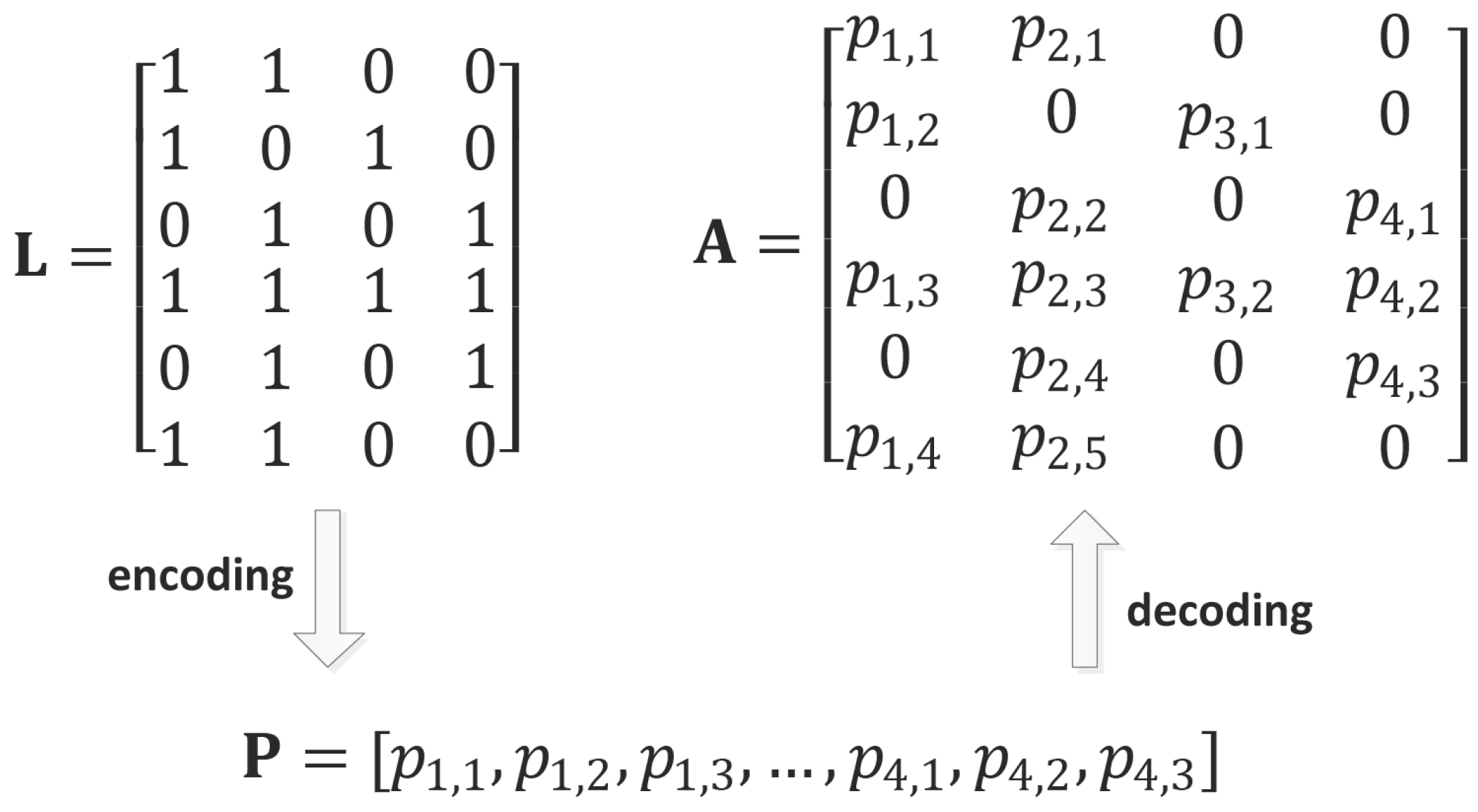
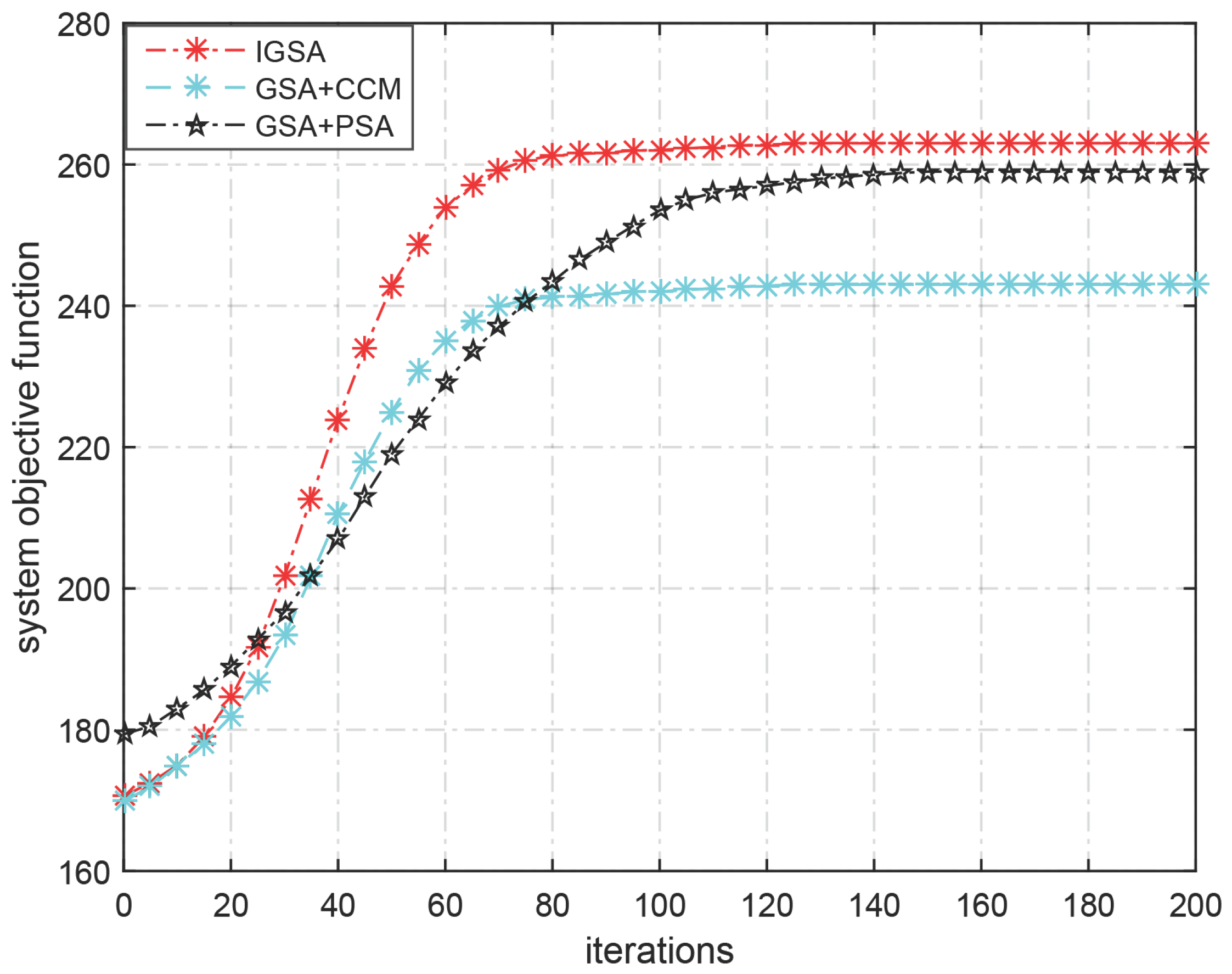

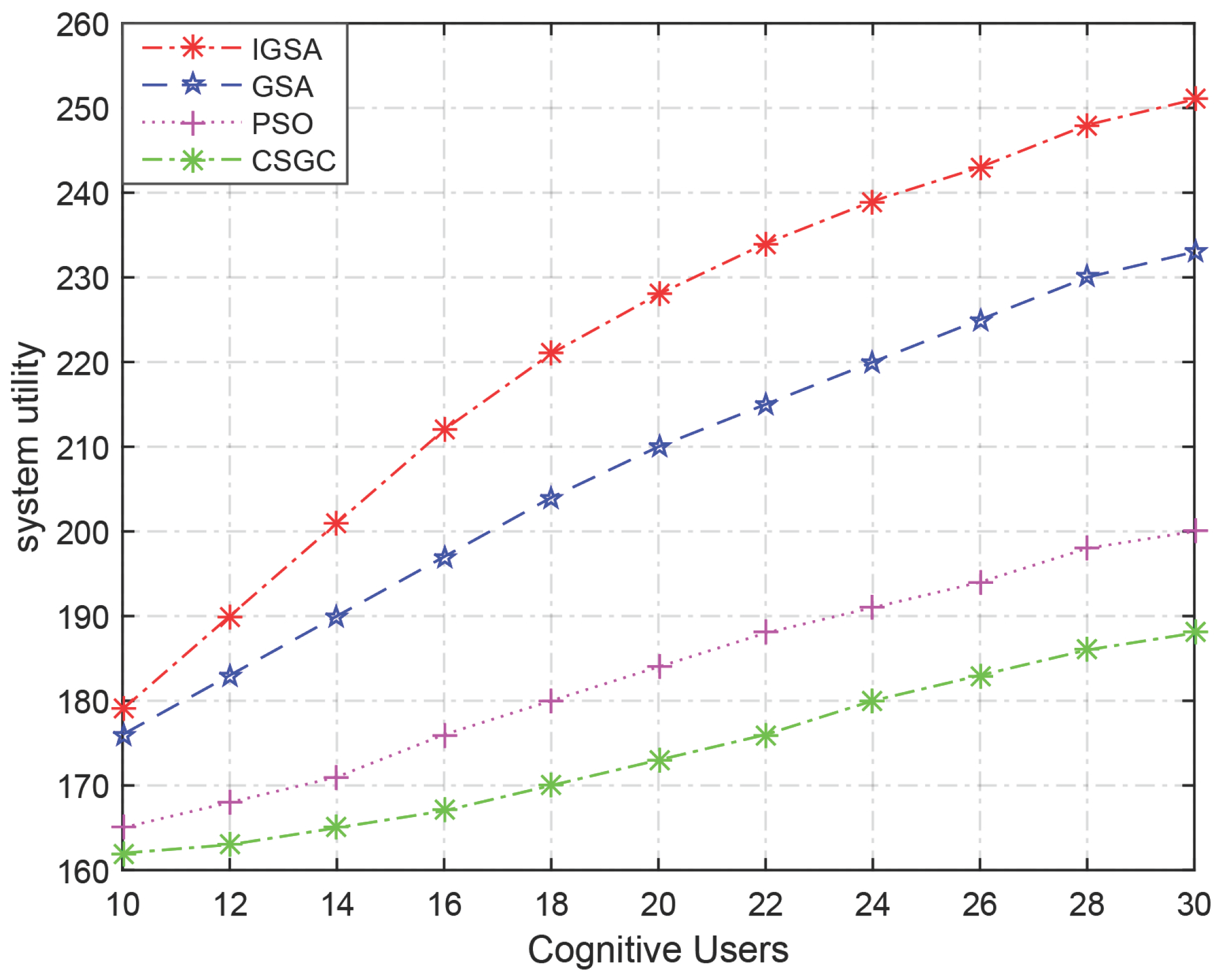
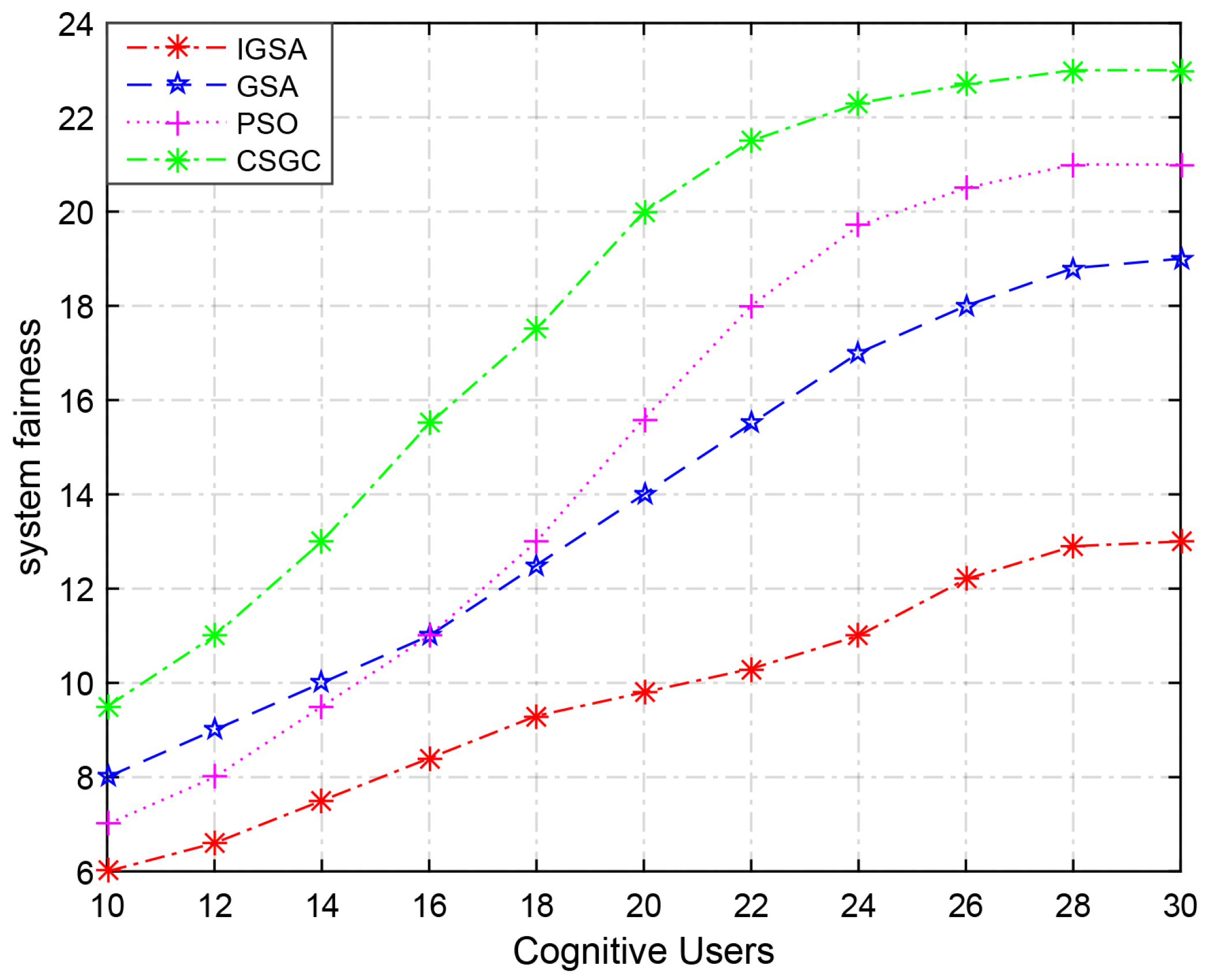
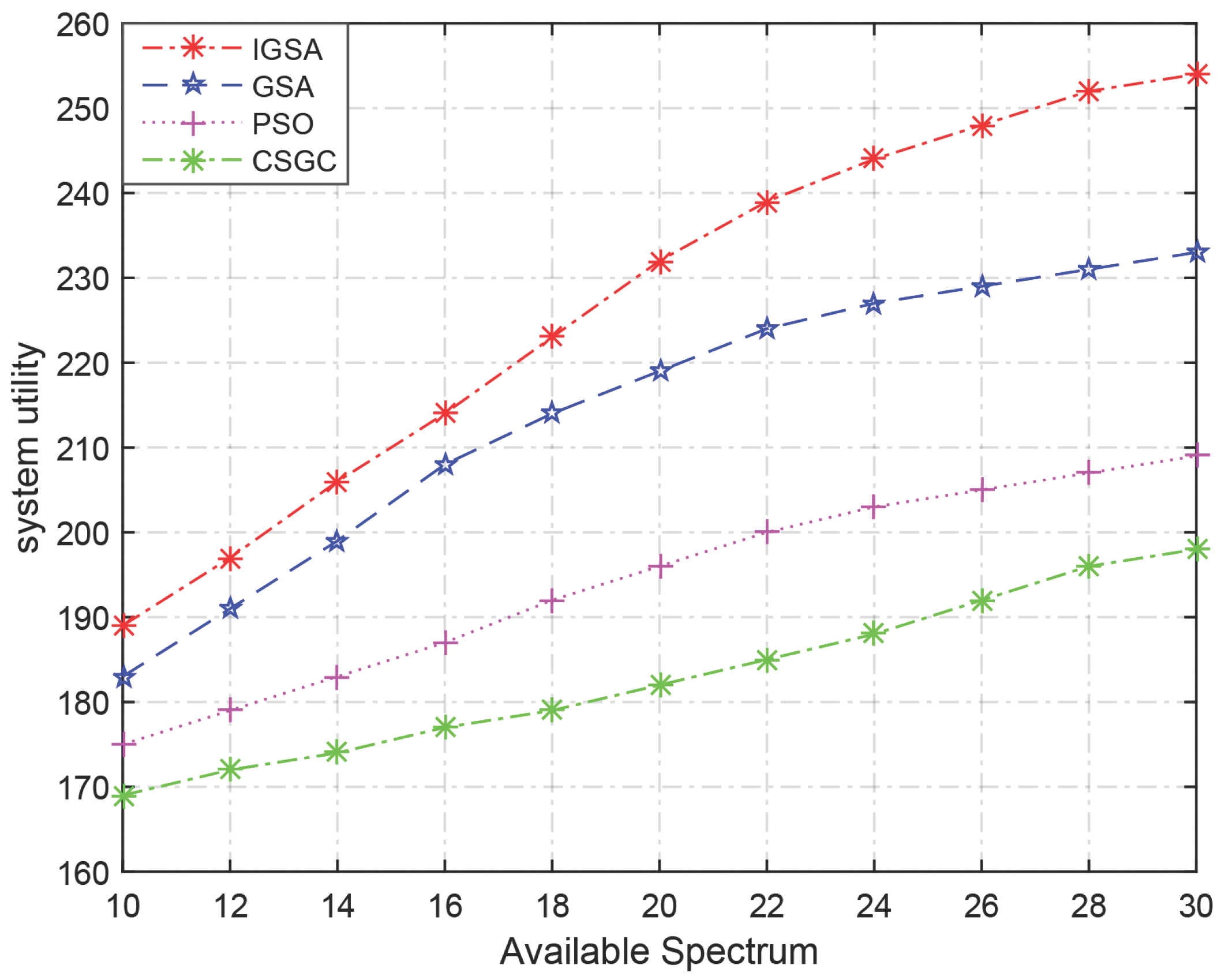
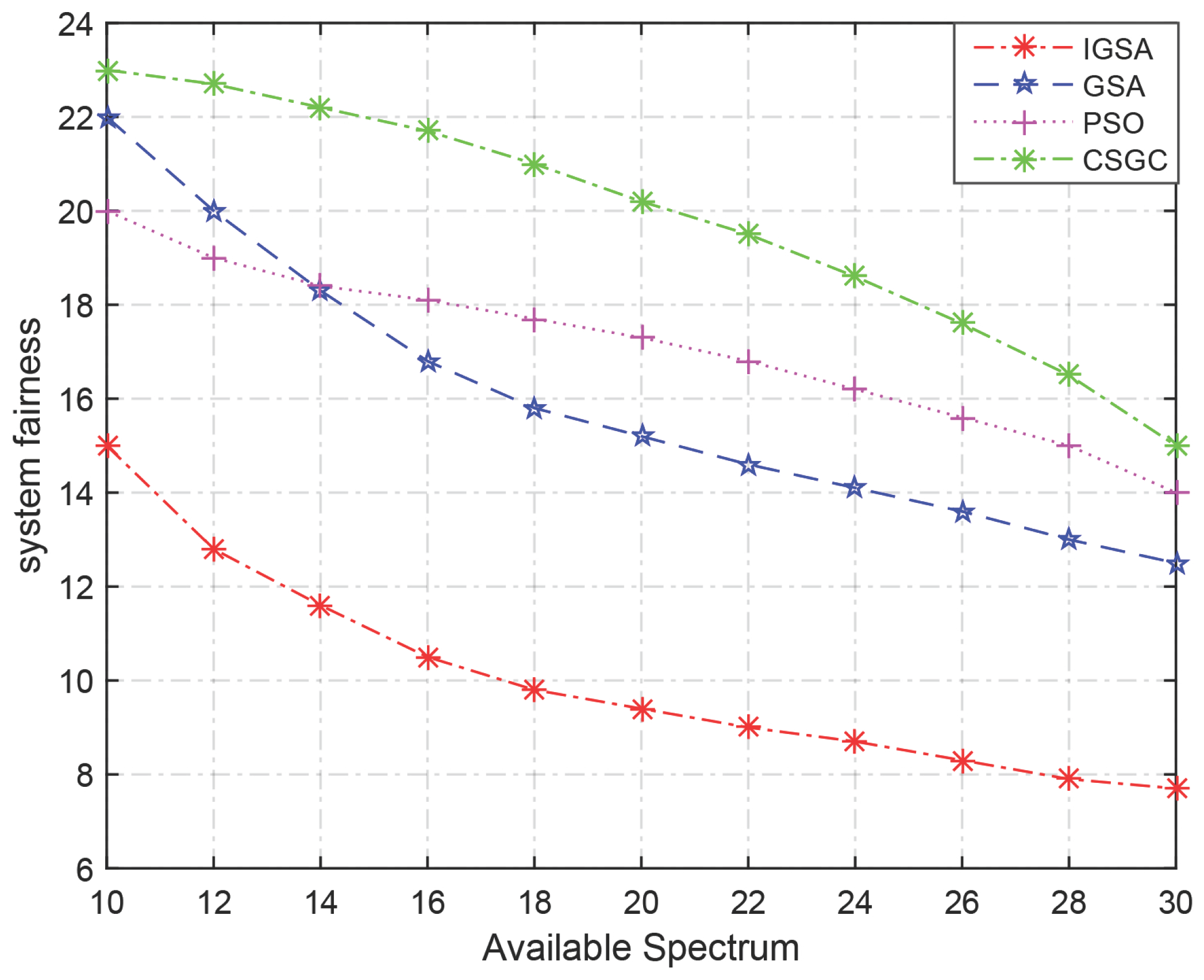
| Algorithm | Specific Parameter | Genetic Parameter | |
|---|---|---|---|
| GSA | the initial gravitational constant the coefficient | population size the maximum iteration | |
| IGSA | the mesh size the shrink factor the enlarge factor | ||
| PSO | the acceleration coefficients , inertia weight , the maximum speed . | ||
© 2018 by the authors. Licensee MDPI, Basel, Switzerland. This article is an open access article distributed under the terms and conditions of the Creative Commons Attribution (CC BY) license (http://creativecommons.org/licenses/by/4.0/).
Share and Cite
Liu, L.; Wang, N.; Chen, Z.; Guo, L. Spectrum Allocation Based on an Improved Gravitational Search Algorithm. Algorithms 2018, 11, 27. https://doi.org/10.3390/a11030027
Liu L, Wang N, Chen Z, Guo L. Spectrum Allocation Based on an Improved Gravitational Search Algorithm. Algorithms. 2018; 11(3):27. https://doi.org/10.3390/a11030027
Chicago/Turabian StyleLiu, Liping, Ning Wang, Zhigang Chen, and Lin Guo. 2018. "Spectrum Allocation Based on an Improved Gravitational Search Algorithm" Algorithms 11, no. 3: 27. https://doi.org/10.3390/a11030027





